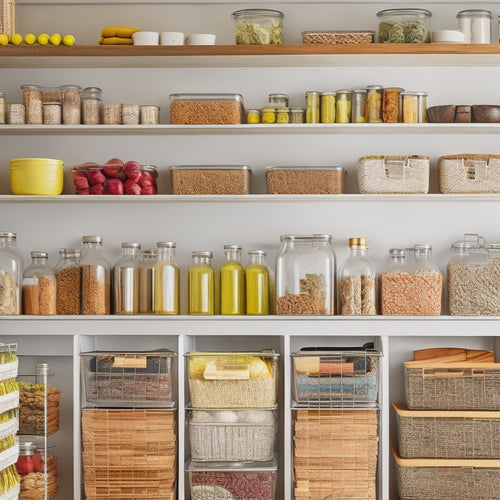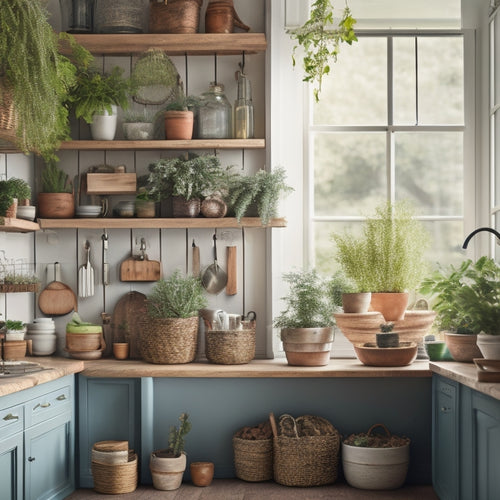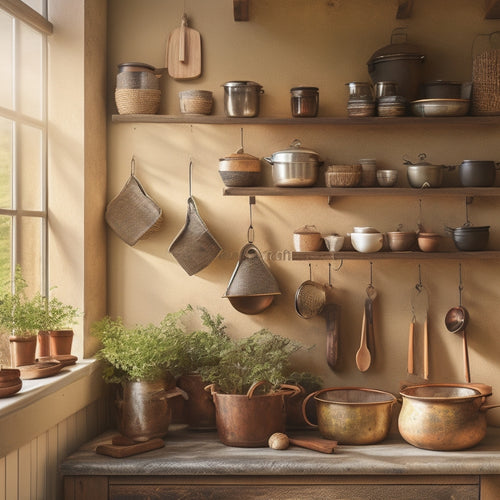
3 Essential Tips for Clutter-Free Kitchen Utensil Storage
Share
To achieve a clutter-free kitchen, start by designating a utensil station, where you categorize utensils into baking, cooking, serving, and more, and assign specific zones for each category. Next, optimize your kitchen's vertical storage space by installing shelf dividers, using wall anchors, and keeping frequently used utensils within easy reach. Finally, utilize hidden storage areas like the back of cabinet doors or kitchen islands by repurposing them into functional storage spaces. By following these essential tips, you'll be well on your way to a more organized kitchen - and there's even more you can do to take your kitchen to the next level.
Key Takeaways
• Designate a utensil station with categorized zones and labeled signage for easy access to baking, cooking, and serving utensils.
• Maximize vertical storage space by installing shelf dividers and wall anchors to hang frequently used utensils within easy reach.
• Utilize hidden storage areas like the back of cabinet doors or kitchen islands by installing pegboards or cabinet organizers to store utensils.
• Assign specific drawers or countertop areas for different utensil categories to maintain a clutter-free kitchen.
• Label each zone and storage area to ensure utensils are easily found and returned to their designated spaces.
Designate a Utensil Station
Where do you currently store your kitchen utensils, and is it a setup that's working for you? If you're constantly digging through drawers or cluttered countertops to find what you need, it's time to designate a utensil station. This will help you stay organized, reduce stress, and make cooking more efficient.
To create an effective utensil station, start by dividing your utensils into categories, such as baking, cooking, and serving. Then, assign a specific zone for each category.
For example, you could designate a specific drawer or countertop area for your baking utensils, another for cooking utensils, and so on. Use station signage to label each zone, making it easy to find what you need at a glance.
Optimize Vertical Storage Space
By maximizing your kitchen's vertical storage space, you can keep frequently used utensils within easy reach while keeping countertops clutter-free. This is especially important for utensils that you use daily, like kitchen shears, garlic presses, or stand mixers.
To optimize your vertical storage, install shelf dividers to separate and categorize your utensils. This will prevent clutter from building up and make it easier to find what you need.
Additionally, consider using wall anchors to hang utensils like pots, pans, or utensil holders. This won't only free up shelf space but also keep your countertops clear. When choosing wall anchors, make sure to select ones that can hold the weight of your utensils and are easy to install.
Utilize Hidden Storage Areas
You can create additional storage space in your kitchen by repurposing areas that are often overlooked, such as the back of a cabinet door or the interior of a kitchen island. These hidden areas can be transformed into functional storage spaces with the right tools.
For instance, you can install a pegboard on the back of a cabinet door to hang frequently used utensils, freeing up space in your drawers. Similarly, you can use cabinet organizers to maximize the storage capacity of your kitchen cabinets. Don't forget to utilize the space inside your kitchen island by installing drawers or shelves to store less frequently used items.
To keep your utensils organized, use drawer dividers to separate and categorize your items. This will make it easier to find what you need when you need it. By utilizing these hidden storage areas, you'll be able to reduce clutter and create a more efficient kitchen.
This, in turn, will make cooking and serving others a more enjoyable experience. So, get creative and start repurposing those hidden areas in your kitchen today!
Frequently Asked Questions
Can I Store Utensils in a Kitchen Cart With Wheels?
You can store utensils in a kitchen cart with wheels, but make sure to prioritize cart organization and invest in wheel locks to prevent the cart from rolling away, keeping your utensils secure and within reach.
How Often Should I Clean My Utensil Storage Containers?
You might think cleaning utensil storage containers is a chore, but trust me, it's a game-changer! Aim to deep clean them every 2-3 months for a fresh start, and you'll be serving up a sparkling kitchen in no time!
Are Adhesive Hooks Suitable for Heavy Utensils?
You're wondering if adhesive hooks can handle heavy utensils. Check the hook's durability and load capacity before using it; if it can't support the weight, consider alternative storage options to avoid damage or accidents.
Can I Use a Pegboard for Hanging Utensils in a Rental Kitchen?
You're thinking of installing a pegboard in your rental kitchen? Good luck with that! Just kidding, it's doable! Consider rental limitations and opt for removable adhesive or 3M command strips for a damage-free install. Customize your pegboard to fit your utensil needs.
Do Utensil Organizers Work Well With Non-Standard Utensil Sizes?
You'll find that utensil organizers can adapt to non-standard sizes with custom fits or oversized solutions. Look for adjustable dividers or expandable slots to accommodate unique utensils, ensuring a tailored fit that maximizes storage efficiency.
Related Posts
-

Tiered Racks for Kitchen Pantry Organization
Tiered racks can enhance your kitchen pantry by maximizing vertical storage and increasing visibility. They help you ...
-

Countertop Storage Ideas for Small Kitchens
If you're looking to maximize your small kitchen, creative countertop storage solutions can make a big difference. Em...
-

Wall-Mounted Racks for Kitchen Tool Storage
Wall-mounted racks are perfect for maximizing storage in your kitchen. By utilizing vertical space, you can free up u...


